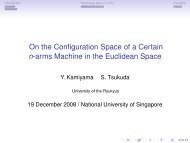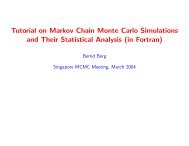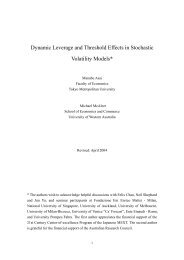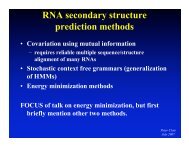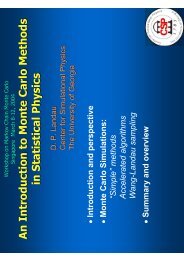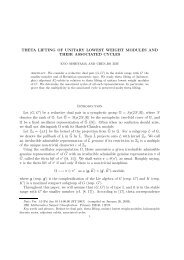Stein's method, Malliavin calculus and infinite-dimensional Gaussian
Stein's method, Malliavin calculus and infinite-dimensional Gaussian
Stein's method, Malliavin calculus and infinite-dimensional Gaussian
You also want an ePaper? Increase the reach of your titles
YUMPU automatically turns print PDFs into web optimized ePapers that Google loves.
denote by F t the …ltration generated by W <strong>and</strong> by the P-null sets of (G), <strong>and</strong> we say that<br />
a stochastic process u (t; !) is adapted, if u (t) 2 F t for every t 2 [0; 1]. If u is adapted <strong>and</strong><br />
R <br />
1<br />
E<br />
0 u (t)2 dt < 1, then the Itô stochastic integral R 1<br />
0 u (t) dW t is a well-de…ned element of<br />
L 2 ( (X)). Moreover, in this case one has that<br />
(u) =<br />
Z 1<br />
0<br />
u (t) dW t<br />
(see [65, Proposition 1.3.11]).<br />
7.2.3 A formula on products<br />
We conclude with a general (useful) formula involving products of <strong>Malliavin</strong> di¤erentiable r<strong>and</strong>om<br />
variables <strong>and</strong> elements of dom (). The framework is that of a general isonormal process<br />
X = fX (h) : h 2 Hg.<br />
Proposition 7.5 Let F 2 D 1;2 <strong>and</strong> u 2 dom () be such that: (i) F u 2 L 2 ( (X) ; H), (ii)<br />
F (u) 2 L 2 ( (X)), <strong>and</strong> (iii) hDF; ui H<br />
2 L 2 ( (X)). Then, F u 2 dom (), <strong>and</strong> also<br />
(F u) = F (u) hDF; ui H<br />
: (7.20)<br />
Proof. Consider a r<strong>and</strong>om variable G equal to the RHS (7.2), with f 2 C0<br />
1<br />
E <br />
hDG; F ui H<br />
= E <br />
hF DG; ui H = E hD (F G) GDF; uiH<br />
= E <br />
F (u) hDF; ui H G .<br />
(Rm ). Then,<br />
Since r<strong>and</strong>om variables such as G generate (X), the conclusion is obtained.<br />
7.3 The Ornstein-Uhlenbeck Semigroup <strong>and</strong> Mehler’s formula<br />
7.3.1 De…nition, Mehler’s formula <strong>and</strong> vector-valued Markov processes<br />
Let X = fX (h) : h 2 Hg be an isonormal <strong>Gaussian</strong> process over some real separable Hilbert<br />
space H.<br />
De…nition 7.4 The Ornstein-Uhlenbeck semigroup fT t : t 0g is the set of contraction<br />
operators de…ned as<br />
T t (F ) = E (F ) +<br />
1X<br />
e qt I q (f q ) =<br />
q=1<br />
1X<br />
e qt I q (f q ) ; (7.21)<br />
q=0<br />
for every t 0 <strong>and</strong> every F 2 L 2 ( (X)) as in (6.6):<br />
The Ornstein-Uhlenbeck semigroup plays a fundamental role in our theory. Its relevance for<br />
Stein’s <strong>method</strong> is not new: see for instance the so-called “Barbour-Götze generator approach”,<br />
introduced in [2] <strong>and</strong> [29] (see [80] for a survey). As another example, see [57], [62] <strong>and</strong> the<br />
discussion contained in Section 9, where it is shown that the use of the semigroup fT t g leads<br />
31



